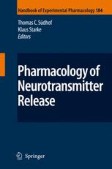Search
Search Results
-
Functional Selectivity at Adrenergic Receptors
The adrenergic receptors have been a model for understanding the structure, function, regulation, and biology of GPCRs. They play a similar role with...
-
Presynaptic Metabotropic Receptors for Acetylcholine and Adrenaline/Noradrenaline
Presynaptic metabotropic receptors for acetylcholine and adrenaline/noradrenaline were first described more than three decades ago. Molecular cloning...
-
G-Protein-Coupled Receptors
G-Protein-coupled receptors mediate many of the hypnotic and analgesic actions of the drugs employed in anesthesia. Notably, opioid agonists...
-
Adrenoceptors and signal transduction in neurons
The adrenergic system is an essential regulator of neuronal, endocrine, cardiovascular, vegetative, and metabolic functions. The endogenous...

-
The Mechanistic Relationship between NREM Sleep and Anesthesia
The mechanisms by which both natural sleep and anesthesia generate and maintain a loss of consciousness are currently the focus of much...
-
Adrenergic and Cholinergic Compounds
Adrenergic and cholinergic signalling contributes significantly to the endogenous antinociceptive system. Exogenous α2 adrenergic agonists have a...
-
The Anterior Hypothalamus and Salt-Sensitive Hypertension
Early studies in our laboratory suggested that in young (3–12 weeks of age) male spontaneously hypertensive rats (SHR), ingestion of a high NaCl diet...
-
The involvement of α2-adrenoceptors in the anticonvulsive effect of swim stress in mice
Rationale: Various studies have shown that stressful manipulations in rats and mice lower the convulsant potency of GABA-related, but also some...
-
Neurobiology of nitrous oxide-induced antinociceptive effects
Nitrous oxide (N 2 O), or laughing gas, has been used for clinical anesthesia for more than a century and is still commonly used. While the...
-

-
The differential effects of prenatal stress in rats on the acoustic startle reflex under baseline conditions and in response to anxiogenic drugs
Rationale: The prenatal stress syndrome (PS) is characterized by exaggerated behavioral and physiological responses to stressful stimuli and...
-
Analysis of the receptor involved in the central hypotensive effect of rilmenidine and moxonidine
The aim of this study was to determine whether α 2 -adrenoceptors or imidazoline I 1 -receptors are responsible for the central sympathoinhibition...
